Tomb of Jahangir
Lahore is a city full of historic buildings, and the Tomb of Jahangir is among the most famous tourist attractions. Mughal Emperor Jahangir was an essential part of the history of this era. He ruled from 1605 to 1627.
His mausoleum was built ten years after his death. Emperor Shah Jahan, son of Emperor Jahangir, built his Tomb at the bank of River Ravi in the suburbs of Lahore.
If you move northwest from the Walled City of Lahore, you will come across the area of Shahdara Bagh. This location was famous for its pleasure gardens in the Mughal era. Jahangir Tomb was also built in his favorite pleasure garden Bagh-e-Dil Kusha.
The Tomb of Jahangir is famous for its exquisite interior and exterior. The interior is embellished with white marble and frescoes, whereas the surface is dominated by pietra dura. Jahangir Tomb Lahore, the Tomb of Asif Khan, and Akbari Sarai are part of the UNESCO World Heritage tentative list.
Interesting facts about the Jahangir Tomb
- It is located in Shahdara Lahore, a suburban area adjacent to River Ravi.
- The Tomb is located in Dil Kusha Garden, one of the pleasure gardens of Emperor Jahangir.
- His wife, Noor Jahan, designed Jahangir Tomb.
- It covers an area of 55 acres.
- It was built ten years after Emperor Jahangir’s death on the order of his son and Emperor Shah Jahan.
- The design of this Tomb is Chahar Bagh patterned with vast gardens surrounding the mausoleum.
- On the west side of the Jahangir Tomb in Dil Kusha Garden, you will see Asif Khan’s Tomb and Akbari Sarai.
- The Asif Khan Tomb, Akbari Sarai, and Jahangir Tomb are all part of the UNESCO world heritage tentative list.
- The construction cost of the Jahangir Tomb in 1637 was estimated to be Rs.10 Lakhs.
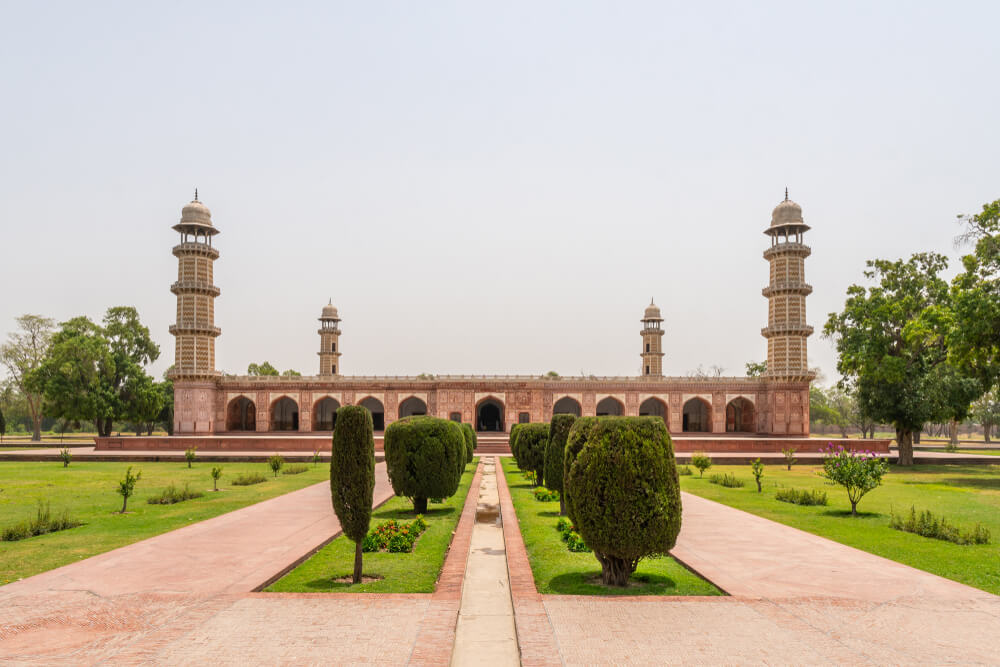
History of Jahangir Tomb
In 1627, Mughal emperor shah Jahan ordered the construction of a Tomb for his father, Jahangir. This Tomb was completed ten years after Jahangir’s death and cost approximately Rs. 10 Lakhs.
In the early 19th century, the Sikh ruler Ranjit Singh stripped some of the marble from the Jahangir Tomb and used it in different Sikh buildings, including Golden Temple Amritsar. The white marble you see in Hazuri Bagh Lahore was also stripped from here.
Some restoration and repair work was also done in the Sikh period. It was believed there was a whole second story or dome at the top of the mausoleum. But no evidence was found related to it.
During British Raj in Subcontinent, the railway line was built between Asif Khan Tomb and Nur Jahan Tomb. This railway line in Shahdara damaged the ensemble of mausoleums.
Later in the late 19th century and early 20th-century British government repaired the damage done to the Tomb. Jahangir’s Tomb also sustained damage during the River Ravi floods. Restoration of the Tomb was done throughout history.
The architecture of the Tomb of Jahangir
The Tomb spreads on a 55-acre Chahar bagh-styled Garden. Four gardens surround the building through the main entrance, with a fountain in each park. The mausoleum is a square building in the center of the garden. You will see a flat roof structure with only four ornamental octagonal minarets of 100 ft. each.
Like the Tomb of Emperor Akbar, Jahangir’s Tomb also lack the presence of a dome. It is speculated that Emperor Babur’s open Tomb inspired this style in Kabul. The whole flat-top architecture is rare in Mughal history. It is only seen replicated for the Tomb of Nur Jahan. The exterior of the Tomb is covered in a floral red brick pattern. You will see red sandstone embellished with motifs on the exterior wall of the garden.
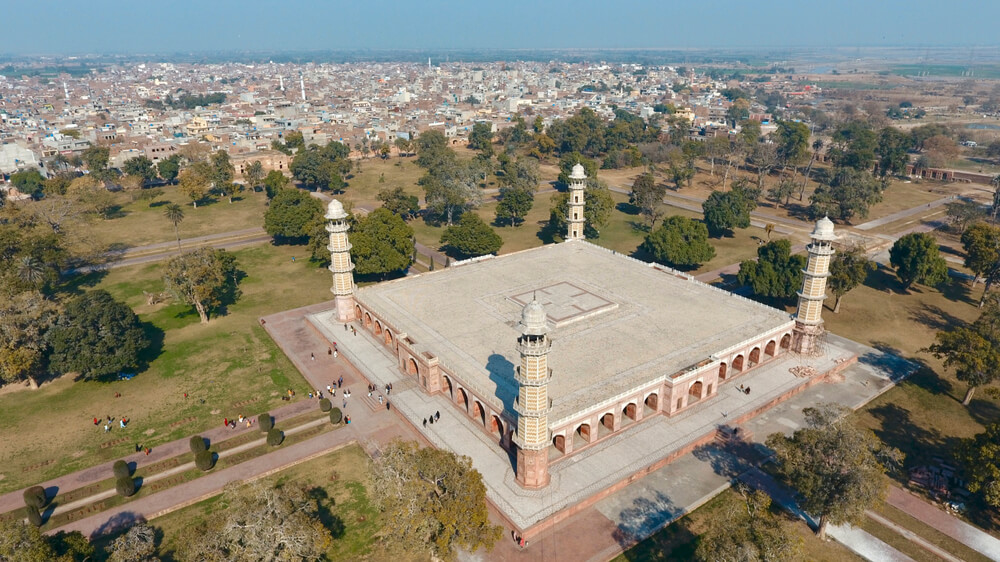
As you enter the mausoleum, a series of vaulted compartments will be seen. Mughal Buon fresco embellished compartments will lead you to the center of the mausoleum. Intricate jali work in these vaults penetrates light through them.
Attractions offered by the Tomb of Jahangir
Tomb of Jahangir offers you many beautiful attractions. While visiting, you can enjoy the vast Chahar bagh-styled gardens. Beautiful and mesmerizing fountains will enchant you. The magnificent Mughal architecture always attracts tourists and travelers. Moreover, the presence of three main Mughal-era attractions in one place will always be an advantage.
You can visit the Tomb of Asif Khan and Akbari Sarai while visiting the Tomb of Jahangir. The Tomb of Noor Jahan is also near.
Charbagh Pattern
The Tomb covers a vast quadrangle, divided into four Chahar bagh-styled gardens. Chaharbagh means four parks. You will see these gardens arranged beautifully to surround the mausoleum.
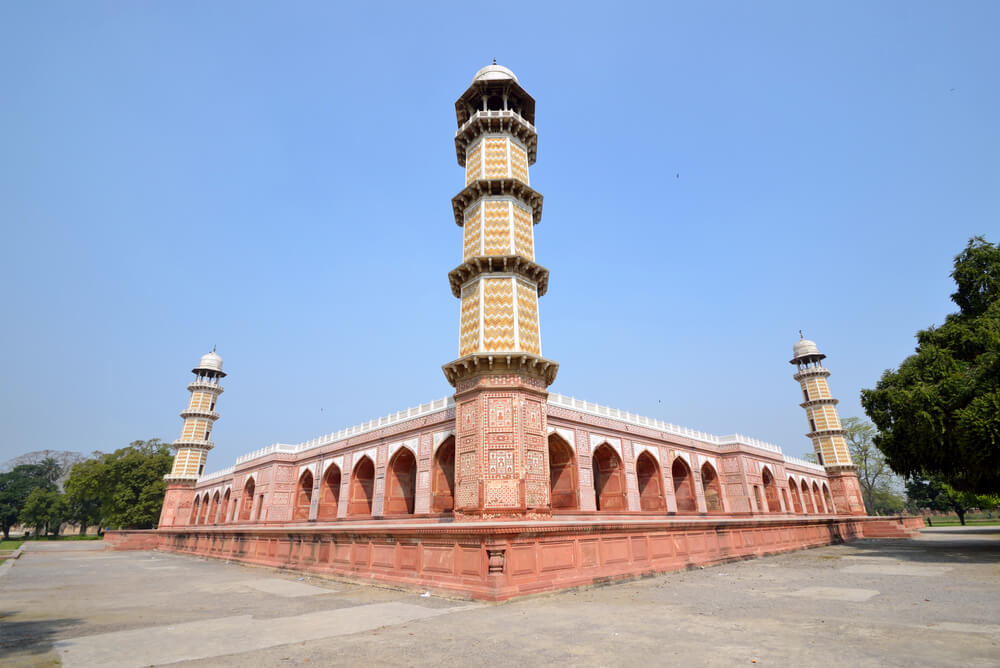
Entrance Gateways
The main entrance to the garden is through the western gate through the Akbari Sarai. Once you pass through Akbari Sarai, you will enter the vast grasslands.
Four Rivers of Paradise
Dividing the gardens are four paved walkways and two intersecting water canals, which give the impression of the Four Rivers of Paradise.
Fountains
Gardens are further divided into miniature parks, and these fountains are installed. You will see many fountains in this garden. Small brick canals connect these fountains. In past times a small well was used to water these fountains, but now this connection is not seen.
Akbari Sarai
On the west of the Jahangir Tomb, a caravan inn known as Akbari Sarai is located. It was built in 1637 and had more than a hundred rooms used by Mughal emperors as a resting place. The gate that you will use to enter the gardens is also the main entrance of Akbari Sarai. You will also see rich embellished white marble in sandstone on the walls of this gate.
A Small Mosque
While visiting the Akbari Sarai, you will see a small mosque beside it. It was associated with the Sarai and was used by those who took a rest in the Sarai.
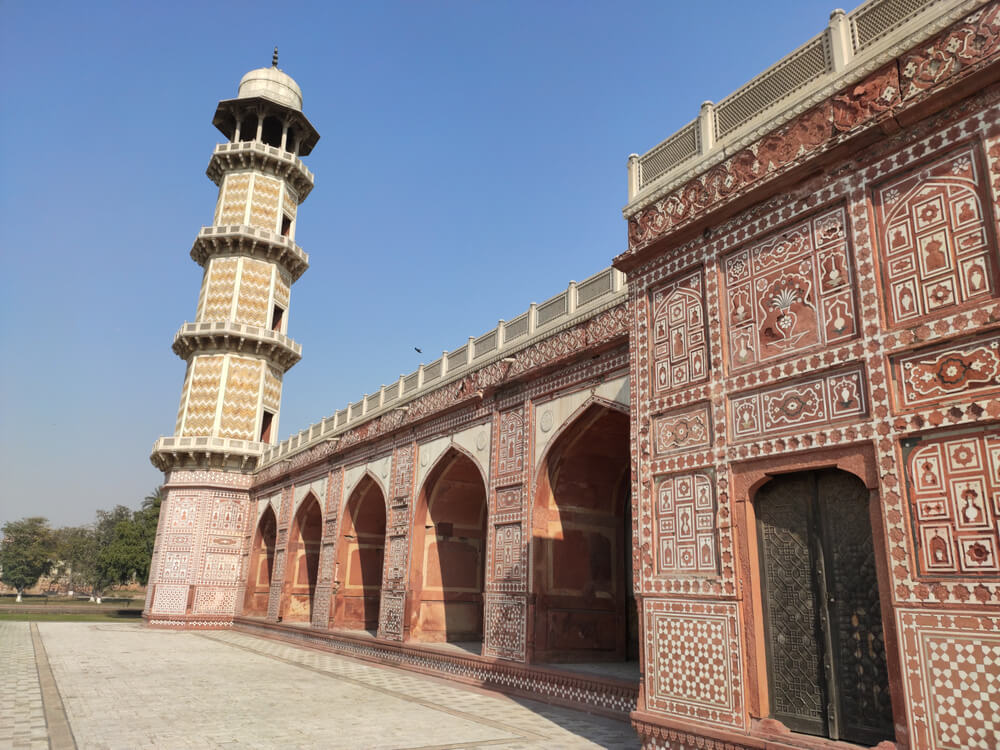
Four Minarets
The structure that visually dominates the whole Jahangir Tomb is the 100 ft. high four minarets. These minarets rise from the building. The base of which is the Tomb itself. These octagonal-shaped minarets are richly decorated and carved with colorful motifs and marble.
Amazing Exterior
The exterior of Maqbara Jahangir is covered in white marble embedded in red stone, which gives this whole structure a remarkable finish.
Vaulted walkways surround the Tomb. The windows that you can see from outside are covered with Jali work.
Jahangir’s Tomb
The remarkable geometric pattern of this Tomb and garden is breathtaking. While entering the park, you can see the resting place of the Mughal Emperor Jahangir. The long corridors open in a central octagonal chamber. This chamber has a main cenotaph made of white marble and embedded with precious stones.

99 Names of Allah on White Marble
The rectangular Cenotaph has 99 names of Allah written on it. You can see the beautiful calligraphy with precious stones on beautiful white marble.
Persian Inscriptions
The Persian language always had a special place in Mughal Era, and most of the poetry was done in it. The central octagonal chamber has Persian inscriptions written on it. This shows the influence of the Persian language in the Mughal era.
Beautiful Interior
The vaulted chambers are embellished with Mughal Buon Fresco. Precious and colorful stone is used in the interior. The most dominating thing you will see in the interior is carved motifs on white marble. The floor is covered with white marble with alternating black geometrical patterns. Terra cotta pattern is also seen on walls. The Cenotaph is inlaid with petra dura vegetal patterns.
Jilau Khana (Forecourt)
Besides Akbari Sarai, a Jilau Khana or forecourt is also present. It was constructed on the west side of the Tomb. It adds more substance to the whole building.
Asif Khan Tomb
This elevated Tomb is located west of the Jahangir Tomb, obstructed by Akbari Sarai. You can see this Tomb on the west side while standing in the main entranceways.
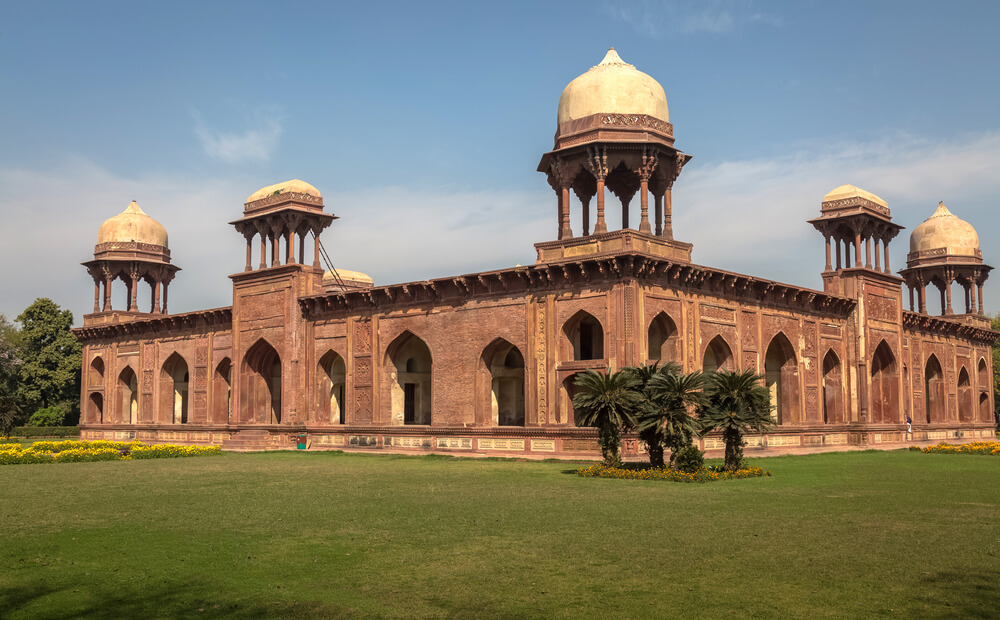
Asif Khan was the brother-in-law of Jahangir, whose Tomb was also made by Shah Jahan in 1641. This whole building was covered in precious white marble and stone. Sikh rulers have heavily damaged this building and stripped most of its marble and stones.
Noor Jahan Tomb
Noor Jahan, the wife of Emperor Jahangir, was buried near him. Her Tomb was also well adorned with white and red marble and sandstone. Most of the marble from her Tomb was stripped off by Sikh rulers.
A railway line was built between the Tomb of Noor Jahan and Asif Khan, separating the two. Before this, these were in the same garden compound. The gardens are no longer present.
Jahangir Tomb Ticket Price
Ticket price varies with time, but it is relatively cheap for locals. The price is a little high for foreigners and tourists. For information on the latest ticket prices, you can contact Lahore Tourism Department.
Jahangir Tomb Timings
It is open seven days a week, and you can come between 9:00 AM and 7:00 PM.
Location of Jahangir Tomb
It is located in Tomb, Circular Road Shahdara Town Lahore, Pakistan.
Conclusion
Located in suburban Lahore, the Tomb of Jahangir is a beautiful example of Mughal architecture. From breathtaking interior to majestic exterior, this place is one of a kind. All this beauty is worth visiting. Words are not enough to describe it; you will understand it once you see it. The above information well explains this place, compelling you to see it.
FAQs
Who built Jahangir’s Tomb?
His son Emperor Shah Jahan built this Tomb and designed it by his wife, Noor Jahan.
Where is the Tomb of Jahangir?
Tomb of Jahangir is located Northwest of the Walled City in Shahdara Town Lahore.
What is the History of Maqbara Jahangir?
Maqbara Jahangir was ordered to be built by his son right after he died in 1627 but was completed after ten years. It is a magnificent mausoleum of the Mughal era.
How do you get complete detail of the Jahangir Tomb?
You can get complete details of Jhangir’s Tomb in this article. Still, suppose you wish to know more about this place. In that case, you can visit the website of the Lahore Tourism Department or can contact Walled City Authority Lahore.
What is the best time to visit Jahangir Tomb?
The best time to visit the Jahangir tomb is in February and March or in October and November, as the weather is relatively pleasant in these months.
